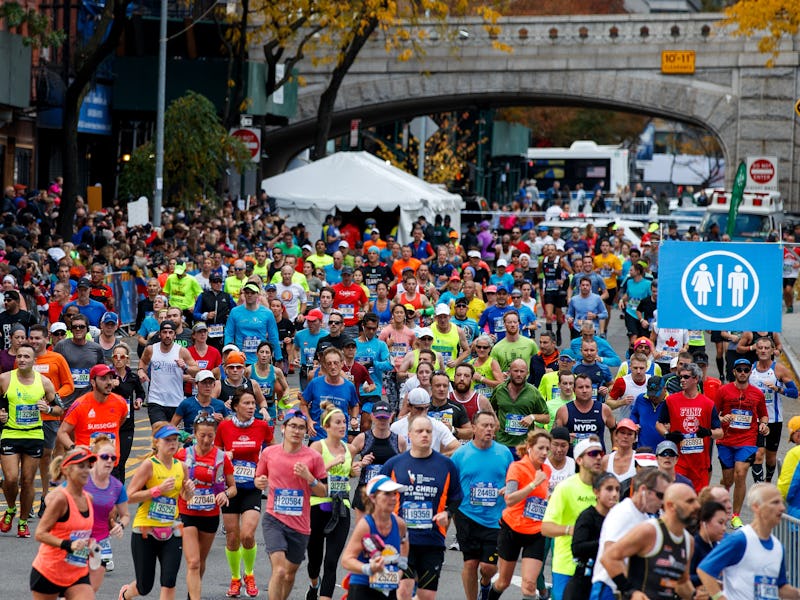Guiding a Blind Runner in NYC Marathon is Just the Start for This GPS Tech
This startup wants to change how people and devices "see" the environment.

Simon Wheatcroft is one of 50,000 runners set to compete in the New York City Marathon Sunday, but there’s a small caveat that separates him from the crowd — he’s blind.
The British athlete and motivational speaker, who lost his sight when he was 17, will run the 26.2-mile course guided only by a wearable GPS device that sends pulses giving him specific directions on where to go. The Brooklyn-based company WearWorks is behind the device, and CEO Keith Kirkland tells Inverse not just how the device will help Wheatcroft Sunday, but how it could revolutionize how all people use their devices interact with the environment.
“Ultimately, we guide you towards the direction of open space,” Kirkland says. “The person is constantly able to know what’s around them.”
Wayband — the navigational armband that Wheatcroft will run with — is the company’s first product and is designed for the blind and visually impaired. The device can communicate directions without any visual or audio cues, which is how mainstream navigational tools function.
The Wayband is a wearable GPS device using touch-based technology.
However, beyond the marathon, Kirkland says this touch-based technology could open doors for ideas and opportunities industries have never thought were possible.
“Visual is really overloaded, but touch is not really explored,” the CEO says. “The whole point is to really expand the human ability to sense our environment.”
It wouldn’t just be blind people would could benefit — WearWorks could help anyone who aren’t in an easy position to look at their phone while they are on the move.
For instance, cyclists on busy streets wouldn’t have to pull out a map application to risk not seeing a car that swerves in front of them. Athletes who cover large geographical areas could focus on looking at the route ahead instead of their phones. Augmented and virtual reality programs could add “tactile feedback” to make their experiences more interactive and theatrical, Kirkland says.
The immediate goal, though, is to help those whose special needs are frequently overlooked by the tech industy. He wants WearWorks to encourage companies to “design with inclusion” and “inspire a generation of designers to make products that are more accessible.”
“If nothing else, we bring an eye to an industry — some call it a niche market — of these people who really have a need for design, that can make people’s lives better,” Kirkland says. “But ultimately, we want to get people off their cell phones and back into the real world.”
The company has spent months fine-tuning the Wayband technology so that the device can communicate to users down to precisely how much they need to turn to go in the right direction. The wristband uses different vibration patterns to indicate different actions and demands. Of the around 500 people with visual impairments who tested the technology, Kirkland says 90 percent of them reported the device accurately pointed them in the right direction, all with vibrations sent through a wearable device.
“With most navigation, when you’re walking into a five way intersection, there’s not enough information to tell you where to go,” Kirkland says. “We have other haptic expression that tells you, ‘Oh, coming up in 20 meters is a right turn.’ With that, you have the confidence to know where to go.”
Simon Wheatcroft during an interview with itv News.
Wheatcroft, who Kirkland considers the “Michael Jordan of what we’re doing,” has worked with WearWorks to design and test the product for the past six months. Kirkland says the British marathoner tested the first version of the Wayband during the Boston Marathon when it still had a lot of glitches, but that Wheatcroft has stuck with the company because he believes the technology could defy “the impossible”: to let a blind person navigate straight down the street unguided.
“I’m not doing these things just so I can be the first to do this and the first to do that,” Wheatcroft told the UK’s ITV News. “What I’m interested in is making sure this technology exists to help everybody.
WearWorks is planning to release its first round of Waybands as soon as Wheatcroft crosses the finish line at the marathon, Kirkland says. The company will select 100 to 200 applicants who preorder the product, focusing first on keeping the device affordable and available to the visually impaired. But Kirkland says that by November of next year, he expects the Wayband could be available to buy by the general public.